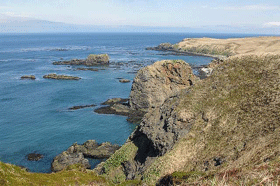July 17, 2009
Air Date: July 17, 2009
FULL SHOW
SEGMENTS
GE Corn Causes Concern
View the page for this story
The agricultural giant, Syngenta, has petitioned the U.S. Department of Agriculture to grant its new genetically modified corn a non-regulated status. This means that the company’s new seeds could be grown without management or geographic restrictions across the country. Some food experts, and farmers, fear that if this corn is grown without limits, it could end up in the food supply. Living on Earth’s Jessica Ilyse Smith reports. (07:20)
Preventing Food Colonies
View the page for this story
Some of the richest countries are buying up large swatches of land in some of the poorest countries. The wealthy foreigners produce crops abroad for pennies on the dollar and then ship the goods home. Olivier De Schutter is the United Nations Special Rapporteur on the Right to Food. He discusses the ethical quandaries of this new colonialism with host Jeff Young. (04:45)
Politics Grow Green in Bulgaria
View the page for this story
Several generations of Eastern Europeans were discouraged from taking part in politics. That legacy lives on but in Bulgaria, youth are cutting through the apathy with a politics based on their love of the planet. From Bulgaria, Matthew Brunwasser reports. (07:30)
Transforming Transportation
View the page for this story
Congressman Jim Oberstar, chair of the House Transportation and Infrastructure Committee, just made public his proposed transportation bill. This $500 billion bill covers everything from funding for highway construction projects to a new high-speed rail system. Congressman Oberstar talks with host Jeff Young about his plans for the future of U.S. transportation. (05:30)
Taking the “Rat” out of Rat Island
View the page for this story
Alaska’s Rat Island may need a new name. Thanks to a two year, two and a half million dollar eradication project, the island’s signature, but invasive, rodent resident has finally been given the boot. Steve MacLean, Polar Marine Program Director for the Nature Conservancy, tells Steve Curwood about one of the world’s largest island rat eradication efforts. (05:20)
Listener Letters
View the page for this story
Following environmental news can be a pretty gloomy task. But Living on Earth has its rays of sunlight, too. We dip into our mailbag to hear what on Earth keeps our listeners happy, as well as what they want to gripe about. (02:00)
Unscientific America
View the page for this story
A new Pew Research Center poll has found most Americans don't believe in evolution, don't think climate change is human-induced, and don't know that electrons are smaller than atoms. Journalist Chris Mooney says the findings point to America's collective scientific illiteracy. He co-authored the book "Unscientific America" and talks with host Jeff Young about what's at stake if we don't get our science straight. (08:00)
If We Can Put a Man on the Moon
View the page for this story
For the past 40 years we have been using the moon landing as our gold standard for measuring every one-of-a-kind challenge humans face. Most recently environmentalists have stacked the lunar voyage alongside the crusade against global warming. Host Jeff Young asks NASA’s chief historian, Steve Dick, how this metaphor works and how it fails. (06:30)
Show Credits and Funders
Show Transcript
Host: Jeff Young
Guests: Steve Dick, Steve MacLean, Chris Mooney, Representative James Oberstar, Olivier De Schutter
Reporters: Matthew Brunwasser, Jessica Ilyse Smith
[THEME]
YOUNG: From Public Radio International - this is Living on Earth.
[THEME]
YOUNG: I’m Jeff Young.
A genetically modified kind of corn could make the production of ethanol more eco friendly. But some scientists and farmers worry that corn designed for fuel could contaminate our food.
RISSLER: Will some people have an allergic reaction to this enzyme? It has never been in the food supply before. So we have no idea what the reaction of the general population or a subset of that would be.
YOUNG: Also – how America’s weak grasp of science undermines the fight against climate change.
MOONEY: So you got a politicized issue and you've got a huge gap between scientists and the public, you add that to unfortunately a lot of bad media coverage of the issue over time and you pretty much get the gridlock that we have.
YOUNG: Unscientific America. Those stories - and more - this week on Living on Earth! So stick around.
[THEME]
GE Corn Causes Concern

YOUNG: From the Jennifer and Ted Stanley Studios in Somerville, Massachusetts, this is Living on Earth. I’m Jeff Young.
Nearly a quarter of the corn planted in the United States does not go to groceries or feedlots—it goes in our gas tanks as ethanol. Now agriculture giant Syngenta has genetically engineered a new strain of corn to be grown specifically for ethanol--not for human consumption.
The US Department of Agriculture is about to decide how it should be regulated.
And Living on Earth’s Jessica Ilyse Smith reports concerns are cropping up about this genetically modified corn ending up in our food.
[SOUND OF RAIN]
SMITH: Heavy rains fall from dark grey clouds onto the seemingly endless rows of corn on Czajkowski Farm in Hadley, Massachusetts. Joe Czajkowski walks through the rows checking on his crops.
CZAJKOWSKI: They say, rain makes grain, and I think we’re in the right place for that today.
SMITH: Czajkowski grew up among these cornfields, watching his grandfather who started this farm in 1914.
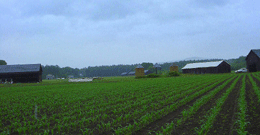
Czajkowski Farm in Hadley, Massachusetts. (Photo: Jessica Ilyse Smith)
SMITH: The corn grown on Czajkowski’s 300-acre farm is mostly for human consumption. But, twenty four million acres of US grown corn goes to ethanol production. Now, Syngenta wants to introduce a genetically modified strain of corn for ethanol into this mix. That concerns Czajkowski.
CZAJKOWSKI: I think we really have to have a better understanding of what this all means and what effects it will have.
[SOUND OF WALKING IN RAIN]
SMITH: Czajkowski sloshes to a nearby barn to get out of the rain. He’s worried that pollen from genetically engineered corn could drift into his crops.
CZAJKOWSKI: Most of the pollen from corn falls within 20 to 50 feet of where the tassel releases the pollen. Pollen stays pretty close to home, but with the right conditions it can travel a little ways; it doesn’t move that far, but it does travel.
SMITH: Most scientists agree that pollen can drift. Ruth Hazzard coordinates the University of Massachusetts Extension vegetable program.
HAZZARD: It’s usually viable about 24 hours, but with higher humidity and cooler temperatures it could remain viable longer, with prevailing winds, it could move farther.
SMITH: Hazzard cites a University of Maine study that looked at the potential for pollen to drift from a genetically modified cornfield to a field of conventional corn. Researchers looked at two fields 30 and 100 meters from the genetically modified cornfield. By the end of the two-year study, genetically modified plants, were growing in both fields.
HAZZARD: If you are talking expanding this into millions of acres where you have food crops and industrial crops next to each other, I think that it would be virtually impossible to avoid contamination of the food crops.
SMITH: Syngenta declined to comment for this story, but some industry scientists say that this newly engineered corn has environmental benefits that outweigh the concern of drifting pollen. Dr. Michael Wach is a managing director of science and regulatory affairs at the Biotechnology Industry Organization. He says that Syngenta’s new corn, which is scientifically referred to as Event 3272, is modified to tolerate heat—so less energy will be needed to produce ethanol.

About a quarter of all corn acreage in the United States is for ethanol.
SMITH: Wach says this enzyme makes producing ethanol more efficient because it cuts out the need to cool large amounts of water in the production process.
WACH: And we’re talking about large volumes of liquid here when we make ethanol from starch, and therefore if you don’t have to do that it save a lot of electricity. And that converts to saving money and that converts to making the ethanol a more carbon-neutral product.
SMITH: Syngenta has petitioned the U.S. Department of Agriculture to grant this corn non-regulated status. Michael Gregoire, the deputy administrator of the USDA’s Biotechnology Regulatory Services, says this status will make distribution of their corn easier.
GREGOIRE: Basically what non-regulated status means is that they are no longer subject to our regulatory restrictions or oversight so they can be moved in or stored or planted without any permit from the agency.
SMITH: If Syngenta can show the new corn won’t cause disease or injury to other plants—pose what’s called a plant pest risk—Gregoire says it will win non-regulated status.
And if the USDA gives Syngenta the green light, farmers will be able to grow this corn without restriction, making it the first non-regulated, genetically modified crop grown in the U.S. solely for industrial purposes.
This worries Dr. Jane Rissler at the Union of Concerned Scientists. She’s deputy director of the organization’s Food and Environment Program. Rissler says that if Syngenta’s corn is commercialized it is inevitable that food corn will be contaminated…and this could lead to health problems.
RISSLER: We’re concerned about the allergenicity of this enzyme—that is, will some people have an allergic reaction to this enzyme. It has never been in the food supply before, so we have no idea what the reaction of the general population or a subset of that would be.
SMITH: Rissler points out that food processors are also worried about the quality of their products if the new corn gets into the food supply. The enzymes in Syngenta’s genetically engineered corn survive at very high temperatures so they do not breakdown during baking and other food processing. So, there could be consequences…
RISSLER: For example, cornstarch that is used to thicken pies that you buy in the grocery store—this enzyme would have survived the baking process and could break down the cornstarch, which is used to thicken the pie, could break it down to sugar. That means that when you bought the pie it would be watery not thickened.
SMITH: But Rissler’s biggest concern is that non-regulated status for Syngenta’s corn could set a bad precedent. She says that the USDA’s recent public notice included a new take on what should be considered a plant pest. With this new interpretation, she says, most genetically engineered crops are no longer considered plant pests.
RISSLER: And this is a startling change from the past 22 years of regulation. A company developing a genetically engineered crop could go to the USDA and say, “according to your new interpretation this crop is not a plant pest. And therefore is not subject to USDA oversight.”
SMITH: This change could have a profound effect on U.S. agriculture.
[SOUND OF RAIN]
SMITH: Back in the soggy cornfield, farmer Joe Czajkowski hasn’t yet made up his mind about genetically modified corn, but wants more public discussion.
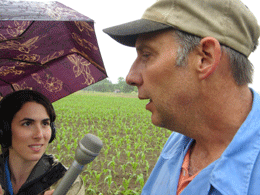
Reporter Jessica Ilyse Smith talks with Joe Czajkowski.
SMITH: The USDA has just wrapped up the public comment period on the proposed regulation of Syngenta’s new corn. And all ears await the fate of Event 3272.
For Living on Earth, I’m Jessica Ilyse Smith in Hadley, Massachusetts.
Related links:
- Read Syngenta’s Petition to the USDA in the Federal Register.
- Read the Union of Concerned Scientists’ comments to the Federal Register.
- The Union of Concerned Scientists
- The Biotechnology Industry Organization
Preventing Food Colonies
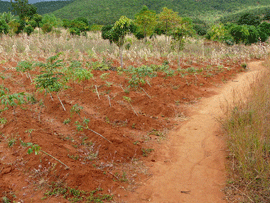
Agriculture in southern Tanzania. Saudi Arabia has bought 500,000 hectares of land in Tanzania. (Photo: Egbert)
YOUNG: Whether the crops go for fuel or food, the world’s rich countries are now looking to the developing world to do more of their farming. A number of wealthy nations are buying or leasing chunks of poorer countries and shipping the crops home-- essentially outsourcing agriculture.
Critics call it a “land grab” and “neo colonialism.” Olivier De Schutter hopes for a more positive outcome. He’s the United Nations Special Rapporteur on the Right to Food. And Mr. De Schutter says the scale of these land deals means the stakes are high.
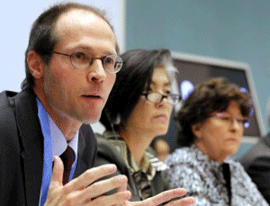
Olivier de Schutter.
YOUNG: Now the way you’re describing it there is sounds like this should be a mutually beneficial deal, but that’s not really the way it’s playing out, is it?
DE SCHUTTER: Well there are essentially three problems. One is access to land for the local population, which often has no remedies available when they are evicted from the land they cultivate. A second problem is food security for the local population because all the surplus food which will be produced will be shipped abroad and will not feed the local population. And a third problem is the transference and the use of the revenues which the host government shall gain from leasing or selling the land to foreign investors. There is no transparency, there is no accountability in the way these revenues shall be used for the benefits of the population.
YOUNG: You know, this sounds a lot like just a new twist on colonialism. Is that what we’re seeing here?
DE SCHUTTER: Well I suppose the critics of these deals do describe these as a form of neo-colonialism. What we did with, you know, the battleships in the past we now are doing with the power of the purse. But of course there are other outcomes possible, and it’s quite clear that if these investments are well managed and if they lead to infrastructures being built and to technologies arriving and to employment being created, then they could be beneficial and then the description of neo-colonialism may not be entirely justified.
YOUNG: So how do we get to that kind of outcome? What are your recommendations?
DE SCHUTTER: Well I put forward some eleven principles which are based on human rights. Basically these principles should ensure that the investors imposed more far- reaching obligations than is currently the case. You know these deals, they concern thousands and sometimes millions of hectares, and they are short documents of three, four pages without any description in these documents of any obligation of investors. For example, to create employment, to respect the environment, to respect the food security of the local population or not to evict peasants. And I think it’s absolutely vital that these obligations be better clarified in the conclusion of these deeds. And so the principles aim to guides states in basically achieving better outcomes.

Agriculture in southern Tanzania. Saudi Arabia has bought 500,000 hectares of land in Tanzania. (Photo: Egbert)
DE SCHUTTER: We have recently passed the bar of one billion people who are hungry, not because we are not producing enough food. These people are hungry because they are poor. The big fear I have and which many people have is that these foreign investments shall increase the gap between the happy few large-scale producers who will benefit and the vast majority of small-scale producers who will be further marginalized because out of one billion people who are hungry today, some fifty percent are small farmers living in developing countries. And these are the ones who need to benefit, these are the ones who need to be helped.
YOUNG: Olivier De Schutter is the United Nations Special Rapporteur on the Right to Food. Thank you very much for your time.
DE SCHUTTER: You are very welcome. Thank you.
[MUSIC: Ce’U “Rosa Meninha Rosa” from Vagarosa (Six Degrees Records 2009)]
YOUNG: Coming up – the rise of the Greens on the borders of the Black Sea. Keep listening to Living on Earth.
Related links:
- Read the UN statement of principles large-scale land purchases.
- Check out Olivier de Schutter's blog.
- Read more about the concern over “land grabs” here.
Politics Grow Green in Bulgaria

Young Bulgarian Greens make noise for nature. (Photo: Claudia Yi Leon)
YOUNG: Now, if you had a problem with a planned highway, you might call city hall, or even protest. But during Soviet rule in Eastern Europe such political expression was rare and risky.
To this day, many East Europeans do not see the people as having much power. That’s starting to change in Bulgaria, where Matthew Brunwasser reports on a generation of environmental activists re-shaping how Bulgarians view government.
[CHANTING, BANGING SOUNDS]
BRUNWASSER: On the streets of the Bulgarian capital, you’re starting to see scenes like this one a lot more often.
[CHANTING]
BRUNWASSER: These young environmentalists are shouting, “we want nature--we don’t want concrete.”
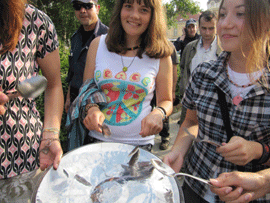
Young Bulgarian environmental protestors in the “let’s make noise for nature” march through the center of Sofia. (Photo: Claudia Yi Leon)
[CHANGING, PROTEST SOUNDS, METAL BANGING]
BRUNWASSER: There was an environmental movement here during the Communist era. In fact it was the only organized political opposition to the regime.
People called it "eco-glasnost" … it protested mainly against nuclear power and pollution from neighboring Romania. The movement gradually became irrelevant and has few connections to activists today.
[SOUND OF WAVES AT A BEACH]
BRUNWASSER: Instead today's Bulgarian environmentalists trace their roots here, to the Black Sea coast.
[WAVES]
BRUNWASSER: It was here on a beach called Irakli, that a young generation of environmentalists stepped in to fight a proposed vacation village. Most Bulgarians didn't believe it was possible for citizens to do anything about unchecked development. There was a sense that Irakli was the only place left untouched on the entire Black Sea coast. The protestors won a year-long ban on construction and a movement was born.
[SOUNDS OF A CROWD]
BRUNWASSER: Genady Kondarev, at 27 a movement veteran, says that after the lies of Communism and rocky ride of capitalism, Bulgarians have already lost a lot.
KONDAREV: And the one thing that they can touch they can feel they can see is the Bulgarian nature. They know this is something beautiful, they know it’s a treasure that we have.
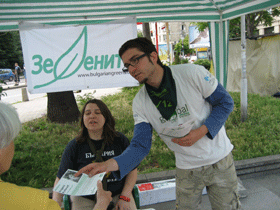
Genady Kondarev, candidate for parliament, in the Greens’ information tent in the center of Sofia talking to voters. (Photo: Claudia Yi Leon)
BRUNWASSER: So in what represented a major decision on strategy, the new environmentalists decided to form a political party, the Bulgarian Greens. It's a shoestring operation, so there was little money for ads like this one.
[RADIO AD IN BULGARIAN]
VOICEOVER: We're the greens. You know us from the protests to defend Irakli and the mountains. We've had our victories, but we want more… to preserve the nature of Bulgaria, unique in Europe for all its magnificence.
BRUNWASSER: The party had the funding to air this commercial on the national radio exactly three times. So the Greens mainly reach THE people by speaking to them directly, often from information tents they set up on streets around the country.
[ACCORDIAN MUSIC]
BRUNWASSER: An accordion-player busks at an exit to the Sofia metro, near where Genady Kondarev is handing out fliers. He decided to run for parliament with the new Green Party. One passerby is clearly agitated.
[AGITATED VOICES SPEAKING IN BULGARIAN]
BRUNWASSER: Kondarev is stoic.
KONDAREV: No, he thinks that we haven't done anything enough for the environment. He’s asking for this wild beach Irakli. He thinks that we have been sponsored by some people: this is the usual voter who equals everyone in the politics to the mafia.
BRUNWASSER: It's good that Kondarev knows how to speak patiently. Many Bulgarians are totally unfamiliar with the concept of participatory citizen politics.
[KONDAREV SPEAKING BULGARIAN AS HE HANDS OUT FLYERS]
BRUNWASSER: Dimitar Buchkov stops to chat. He says the Greens represent hope for the future.
BUCHKOV: Someone must care for this nature. Because the rulers in the country, they would like to accumulate more money for short time, they would like to be millionaires or billionaires in a night. This is terrible. And that is why we have to kick them out of the power.
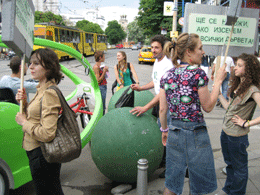
Supporters gather to agitate for the Bulgarian Greens before the elections. (Photo: Matthew Brunwasser)
KRASTEV: This is good. The fact that they made a political party, the fact that they decided to run, I find this extremely extremely positive development.
BRUNWASSER: Krastev says that the Greens have practically introduced voting to Bulgarian youth, who are almost totally apolitical.
KRASTEV: They are trying to tell people, look there is a public good. And because for the last 20 years the idea of the public good has disappeared from Bulgarian political life, its always been the interests of us against the interests of others, I find the energy coming from the green movement much more important than the votes than they are getting.
[SAMBA BEAT PROTEST]
BRUNWASSER: The greens have clearly made politics fun. But when the votes were counted in recent parliamentary elections, the party got 22,000 votes, less than the 1% they were hoping for. That would have won them state support, like an office. No one expected the 4% needed to enter the Parliament. Yet Kondarev says the campaign has made them tough, and taught them how to fight.

Genady Kondarev bangs spoons in the march “lets make noise for nature.”
BRUNWASSER: Everyone is trying to get us on their side now, he says. The big parties in Bulgaria now have environmental planks in their programs. And all are eager to harness the energy of the earnest young Greens. Almost 20 years after the fall of the Berlin wall, youth, and concern about the environment are healing the political wounds of Communism. The Greens say they have just gotten started.
For Living on earth, I'm Matthew Brunwasser, in Sofia, Bulgaria.
[PROTEST MUSIC, WHISTLES]
Transforming Transportation
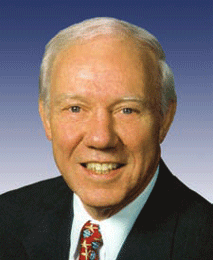
Congressman James Oberstar.
YOUNG: It’s Living on Earth, I’m Jeff Young.
Politicians love pavement. So when Congress writes a transportation bill, it usually means more highways. But Minnesota Democrat James Oberstar wants to move transportation in a different direction.
His bill would also put big money toward transit, trains, bike paths and walkways. Oberstar chairs the House committee on Transportation and Infrastructure. And he thinks Americans are ready to—now brace yourself—get out of their cars, and onto alternatives like high speed rail.
OBERSTAR: We need a long-term sustained investment for intercity high-speed passenger rail. I just tell the story that when I was a student in Bruges, Belgium, traveled to Paris to Brussel and then Brussels to Bruges by train. That trip which is the distance of Washington to New York took six hours in 1956. Today that trip is 45 minutes. Every three minutes from 6 am to midnight a train is leaving in each direction with 1100 passengers on board at 186 miles an hour.
So those kinds of initiatives, those kinds of high-speed rail service are effective, they’re operating, they’re working, and they have sustained government support. And now because of the dependability of that service, because of the high degree of reliability, they are financially self-sustaining as well.
YOUNG: Is this something that Americans are going to take to, though? It’s not really that strongly ingrained in our sense of how we get from point A to point B.
OBERSTAR: Yes, I think Americans are indeed warming and changing their habits. They’re moving to transit. A million new transit riders a day have been recorded over the three years for our nation’s transit systems. Ten and a half billion transit trips last year. At one time, ten years ago, New York City accounted for 60 percent of all transit trips in America. Today, New York City accounts for 38 percent, not because they’re riding transit less, they’re riding it more in New York, but other cities have vastly increased their ridership of transit systems. We just need to make a greater investment. We need to have a mode shift to transit systems like rail circulator systems, streetcars, trolleys, commuter rail. If we succeed in achieving a ten percent mode shift to transit, we will save the equivalent of all the oil we import from Saudi Arabia – that’s 550 million barrels a year. And the nation can and will move in that direction if we provide the incentives and the sustainability of programs.
YOUNG: I’m wondering what role did concern about climate change play in your thinking in putting together this transportation bill.
OBERSTAR: Well climate change is a matter of very grave concern to me. I’ve followed this intensely for well over a decade. I think perhaps the greatest contribution we can make is this ten percent mode shift to transit and get people out of their cars and onto their bicycle. If we can convince people that they’re making a greater contribution by burning 86,000 calories a year on the seat of a bicycle that burning 8 barrels of oil a year in their car, then I think we’ve made a great contribution.
YOUNG: It seems to me you’re fighting up a bit of an uphill battle, though, given the long American love affair with the car.
OBERSTAR: Oh I don’t think people will abandon the automobile. But – give you an example: Boise, Idaho in the 1880s through 1950 or so, had a wonderful streetcar system that started in the downtown, traveled out to the outskirts of the city to a beautiful picnic area. Little further on there was a chapel where weddings took place. And it all was done on the streetcar. And then the streetcar was abandoned in favor of the automobile. And now a few years ago the mayor of Boise invited me out to look at the smog suffocating the city because it’s in sort of a bowl and you have mountains on both sides and the emissions are trapped in this. Now they want to rebuild their streetcar. And they’re working on it. Choices like that are being made all across America.
YOUNG: Do you think if these new high speed routes succeed that they will be something that’s affordable, something that the average people can take advantage of. Because honestly, I got to say, the closest thing we have now to high-speed rail, Acela is often out of my price range.
OBERSTAR: It’s true that the costs are significant. But with increased ridership will come reduced cost.
YOUNG: And speaking of costs, how do you intend to pay for the wonderful things you have outlined in your bill, and do I have the price tag correct – somewhere in the neighborhood of 500 billion?
OBERSTAR: Its 450 billion for the Highway Transit and Safety programs. An additional $50 billion in an infrastructure bank to support the long-term investments needed to sustain high-speed inner city passenger rail. And the highway trust fund with the gas takes highway user fee has proven very successful in the past in creating a sustainable revenue stream.
YOUNG: So, we are in all likelihood looking at some increase in the gas tax from roughly 18 cents a gallon where it is now.

Congressman James Oberstar.
YOUNG: Chairman Oberstar, thank you very much for your time.
OBERSTAR: Good to talk with you.
YOUNG: Representative James Oberstar, chair of the House Transportation Committee.
[MUSIC: The Clash “Walking The Slidewalk” from London Calling: The 25th Anniversary Edition (Sony BMG 2004)]
Related links:
- The website for the House Transportation and Infrastructure Committee
- Check out Congressman James Oberstar’s website.
Taking the “Rat” out of Rat Island
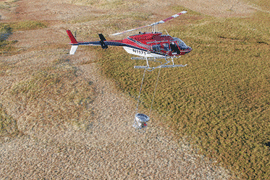
A helicopter flings rat bait over Alaska’s Rat Island. (Photo: Aleutian Fox)
YOUNG: Rat Island off of Alaska might need a new name. A two-year, two and a half million dollar e-rat-ication project gave the island’s signature rodent the boot. The federal government teamed with private groups like the Nature Conservancy for the largest rat removal in U.S. history.
Steve MacLean, Polar Marine Program Director for the Nature Conservancy, told Living on Earth’s Steve Curwood how the rats got there in the first place.
MACLEAN: Well Rat Island is an island out in the Aleutian Islands, about 1300 miles from Anchorage. In about 1780 a fishing boat went aground on the rocky shores. It was a small boat, a small number of rats, but 230 years later the rats had really run over the entire island and decimated the seabird populations that existed there.
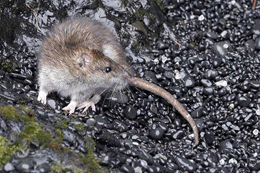
This brown rat, Rattus norvegicus, is the target of succesful eradication efforts on Rat Island. (Photo: Aleutian Fox)
CURWOOD: So how do you go out fixing a problem of this size?
MACLEAN: Well we spread out bait containing a rodenticide around the island using helicopters with specially designed and manufactured buckets underneath, like agricultural fertilizer buckets that would spread the bait in a pattern around the island and then allow every rat the opportunity to consume a lethal dose.
CURWOOD: Rats are pretty wily. They wouldn’t eat something that was obviously poisonous.
MACLEAN: Yeah, that’s one of the considerations that we had to think about in that they are neophobic, so they’re very curious and careful about new things in their environment. So this is a second-generation rodenticide, which means that it’s a delayed acting toxin, so about four or five days after the rats consume the bait is when they start to feel sick. Once that happens, typically they go into their burrows and the vast majority of the rats actually die in their burrows, underground.
CURWOOD: So this rat poison that you spread, why wouldn’t the birds eat this?
MACLEAN: The bait was specially designed so that it would not be attractive to birds that might be on the island. It’s large enough that song, sparrows and other small birds wouldn’t be able to eat it whole. Its also colored blue which is a color that is shown not to be attractive to a lot of these birds. And then seabirds are fish eaters and so eating at sea, and so normally would not be picking up things off of the ground to consume.
CURWOOD: But all this poison on the ground, couldn’t it just leach into the soil there and be around for a good while?
MACLEAN: Well the toxin itself is bound very tightly to the grain, and so once the moisture gets into the grain pellet and breaks it down, the toxin becomes unavailable to other organisms. And also after the microbes get ahold, the toxin itself breaks down to carbon dioxide and water, so there are no nasty chemicals that are left behind.
CURWOOD: I’m thinking though about raptors. Eagles are petty lazy hunters, they would rather pick up something that’s already dead and make a meal than work for it. With these rats dying, if most of them went into their burrows, still there was some out there. What kind of raptor or bird kill did you have?MACLEAN: We did find a number of glaucous-winged gull carcasses and some bald eagle carcasses that we didn’t expect.
CURWOOD: How many dead eagles? How many dead gulls?
MACLEAN: We found I believe it was about 180 gulls and 41 eagles.
CURWOOD: It’s a good thing they’re not endangered in Alaska, huh?
MACLEAN: Yes, it really is. Again, that was much higher than we expected to find. The Aleutian Islands has got a population of about 2500 bald eagles. And so we’re confident that this mortality event will not have a lasting population level effect. However, we are very concerned about this level or mortality and are doing everything we can to understand what might have caused the deaths and then how potentially they can be avoided in the future.
CURWOOD: What are you seeing in terms of the recovery of the island ecosystem now that it is at least apparently rat free?
MACLEAN: We’re starting to see the first signs of birds returning to the island. So we’ve got peregrine falcons that are nesting on the island, black oyster catchers which are nesting on the island, but have never been seen before.
CURWOOD: So, well, let’s face it – rats are really pretty tough. They’re feisty, they’re hardy little suckers. [laugh] I mean they cause plagues. I mean when can you be sure that they’re truly gone from the island?
MACLEAN: We’ve set up a series of trap lines across the island using snap traps that you might find in a hardware store, but also wax chew blocks, which is a wax that has been made with peanut butter to actually make it attractive to the rats. And we’ve set those out in grids across the island, and we’ll come back next spring and check to see if the bite marks on the wax would indicate that rats are still present. So what we hope to find is these wax blocks with no chew marks on them whatsoever.CURWOOD: And of course your paraffin chew blocks will rat on any rats that are left.
MACLEAN: Exactly, yeah, there’s the telltale sign that we hope not to find.
CURWOOD: So the rats are gone and therefore the name of the island is gone. What are you going to name it?
MACLEAN: We would love nothing better than to return the Aleut name Hawadax to the island.
CURWOOD: Hawadax, which means…?
MACLEAN: Which means entry or welcome.
CURWOOD: Steve MacLean is the polar marine program directory for the Nature Conservancy. Thank you so much, sir.
MACLEAN: Thank you for having me. It’s been my pleasure.
[MUSIC: Various Artists/Another Fine Day “In 5 from Six Degrees Of The Middle East (Six Degrees Records 2009)]
YOUNG: Just ahead – the cost of being clueless. What we don’t know really is hurting us. Stay with us - on Living on Earth.
YOUNG: It’s Living on Earth, I’m Jeff Young.
Listener Letters
[LETTERS THEME MUSIC]
YOUNG: And now – time for your comments.
Our interview with Harvard Professor Graham Allison about nuclear terrorism set off an explosion of comment – some accusing us of fear mongering, others thanking us for moving the issue off the back burner.
Peter Keenan of Maynard, Massachusetts who hears us on WFCR in Amherst, liked Allison’s “proposal to safely lock away all the world's nuclear weapons” – and wanted it to go a step further.
He writes “if it is feasible to bring all nuclear-armed countries to agree on a lock-up regime, wouldn't it be equally feasible, and much more desirable, to agree on complete abolition of nuclear weapons? Why not?”
And then there was this email from Pat Churchman of Bridgewater, Virginia. She hears us on station WMRA in Harrisonburg. “Just wanted to say, how extremely depressing almost all environmental news is and has been in recent years. Those of us who are trying to do something lose heart and those of us who feel they can't do anything significant anyway, don't even bother to try.”
Well, those words struck a nerve with us here at Living on Earth – we often feel that paralysis of doom and gloom as well – so we called her up.
Pat are you there?
CHURCHMAN: Yes, I am.
YOUNG: Well thanks for joining us. Pat, you sound a little down.
CHURCHMAN: Well, you know, when I wrote that I really was. But I have something to add to that.
YOUNG: Yes?
CHURCHMAN: Last week we went to an environmental conference held at Montree North Carolina Presbyterian Church, which is what we belong to. And we got to go on a field trip to Warren Wilson College.
YOUNG: Uh-huh.
CHURCHMAN: And we were so excited. They showed us their environmental dorm, and they used as much as possible all local materials, timber from their woods. And they had plantings all the way up to the door practically, edible plantings. And they had this amazing composter. They compost the food from their dining hall. I was so impressed, I wrote a letter to Michelle Obama and said you have to go visit Warren Wilson College.
[LAUGHING]
CHURCHMAN: There are positive signs, and we have to look to those.
YOUNG: Well thanks very much for your time. I appreciate it very much, and I hope you keep listening.
CHURCHMAN: Thank you.
YOUNG: Pat Churchman of Bridgewater Virginia.
Well – bad news – good news – or anything else in our show – please get in touch. Email comments@loe.org – or call our listener line, 800-218-9988. That's 800-218-99-88.
[LETTERS THEME MUSIC]
Unscientific America

YOUNG: The Pew Research Center recently polled Americans on science and found puzzling results. Americans like science--84 percent think it has a mostly positive effect on society. But Americans don't really understand science very well.
For example, only a third of those polled accept that humans and other living things evolved over time. And less than half know that electrons are smaller than atoms.
Science writer Chris Mooney's new book explores what this collective ignorance means for our ability to take on big challenges. It's called Unscientific America: How Scientific Illiteracy Threatens our Future.
And Chris Mooney says the gap between scientists and the public is growing.
MOONEY: We think it might be worsening. Certainly there's a long anti-intellectual tradition in America and that sort of waxes and wanes, so you sort of saw it strong during Eisenhower and then you saw it weaken with the best and the brightest during Kennedy and you could say that we’ve gone through that same tradition again with Bush to Obama. But what we’re really worried about now is that science more than ever is going to be behind a lot of the key policy choices that we’re facing.
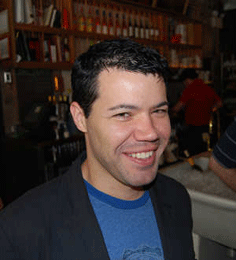
Chris Mooney.
MOONEY: Well there are certainly many and I think by far the largest right now is the climate change issue. That’s the one where the most is at stake for the future, and it’s also the one where you see such a huge gap between the average American in terms of what they think the state of scientific understanding is and then the scientific community on the other hand. The scientists are something like 85 percent sure that it’s human caused. And the public is more like, you know, 50 percent sure. And if you break it out by party affiliation, and this has been done many times, the Republicans overwhelmingly don’t accept the science. So you got a politicized issue and you’ve got a huge gap between scientists and the public. You add that to unfortunately a lot of bad media coverage of the issue over time and you pretty much get the gridlock that we have.
YOUNG: Something you point out here I found pretty interesting and that is among those Republicans who do not think that climate change is caused by humans, it doesn’t seem to matter how educated they are. Even well educated Republicans hold that belief.
MOONEY: Yeah, it’s really amazing, isn’t it? This is a different Pew study. They studied global warming opinions and they looked at party affiliation and level of education. And what they found for Republicans is that the higher the level of education, the less likely they are to accept scientific reality. And for Democrats and Independents it’s precisely the opposite. I don’t find that actually surprising having been involved with debating the climate debate for a long time.
You look at someone who doesn’t accept the science of global warming, like George Will the Washington Post Columnist or Michael Criton the late novelist, someone like that, these people are not stupid, you know, they’re actually quite intelligent, and their intelligence itself is what lets them come up with arguments against the scientific position of the scientific community that are quite ingenious and very misleading.
YOUNG: Now you also point out an example where some liberals have some trouble with some science in the area of vaccination, right?
MOONEY: Right. And this is a newer one that is really sort of taken off in the last decade where a lot of people are convinced that there is an epidemic of autism, and that it’s being brought on by vaccines. And the scientific community has really rejected this claim. They researched it, the rejected it. But a lot of people won’t accept that, and there seems to be a correlation with liberal politics here. And it plays out the same way where you’ve got the scientific position and then you’ve got all these counter arguments that are not accepted but that are wielded by someone like a Jenny McCarthy, a Jim Carey, a Robert F. Kennedy Jr., and a lot of people find those more convincing that the scientific positions.
YOUNG: Huh.
MOONEY: But also we’re seeing you know, the gatekeepers, you know, the media, the treatment of science in the press and, you know, you’ve got a great show and you’re the exception, but that’s dying. You know, people are not even really covering science in newspapers as the newspaper industry implodes. Science on blogs is all opinion. So, we’re really concerned about whether the public will get the science translated to them.
YOUNG: Well, point taken that we in the media could do a lot better here. However, you know, its not always that easy to talk to scientists. Or to get scientists to talk to us in language that we and other lay-people can understand.
MOONEY: Absolutely. So you know, we call this a two cultures problem in the book. The gap between scientists and the media is not just the responsibility of the media. And one thing that Pew studies showed is that scientists think the media does a terrible job. Well, scientists also don’t always do that great of a job knowing how to interact with the media. And that’s something that they should be rewarded for if they’re better at it. And we tell the story of Carl Sagan the great science communicator who was actually punished for being so good at communicating science when he was not admitted to the National Academy of Sciences in 1992. He wasn’t made a member and reports from within the academy suggest that people were putting down his popularizing.
YOUNG: You know, you give one example – I’ll just dive straight in to the relevant lingo here, you give some props to some scientists who helped to make themselves more accessible by using rap. And these are the scientists at CERN’s supercollider.
[LARGE HADRON COLLIDER RAP]
YOUNG: Tell me what we’re listening to here.
MOONEY: It’s basically a rap song about the science they’re doing with the Large Hadron Collider, and it went viral on youtube and it got something like five million views.
LARGE HADRON COLLIDER RAP: Check it. Twenty-seven kilometers of tunnel underground designed with mind to send protons around. A circle that crosses through Switzerland and France. Sixty nations contribute to scientific advance. Two beams of protons swing round, through the ring they ride ‘til in the hearts of the detectors, they’re made to collide. And all that energy packed in such a tiny bit of room becomes mass, particles created from the vacuum. And then….
YOUNG: If I recall, when this thing was about to start up, there was a flurry of stories about how they could unleash a black hole and swallow up the universe or something like this?

YOUNG: So, rapping scientists, is that what it’s gonna take to bridge the divide between science and popular culture here?
MOONEY: [Laughs] I think we should try all things. I think what this shows is scientists being savvy with new media. I mean there’s a lot of bad science on the internet. The leading global warming blog is an anti global warming blog, by traffic. So this is the kind of innovation that scientists should be doing more of.
YOUNG: What are your other solutions here? What do you think we should be about doing that we’re not?
MOONEY: The way we analyze is we look at American science today, and it turns out you’ve got a glut of people getting advanced degrees in science, many more than there are academic positions for. And so we look at that and we say, well, we’ve got more young scientists than we have jobs for and we have a huge gap between science and society, let’s tap into that energy, let’s train them in communications. Let’s send then out into society. Let’s get them working in the media, in politics, in the entertainment industry, all different kinds of things and let’s let their ingenuity and creativity help bridge the gap.
YOUNG: Chris Mooney’s a journalist and co-author of the book Unscientific America: How Scientific Illiteracy Threatens Our Future. Thanks for joining us.
MOONEY: Great to be here.
[MUSIC: Large Hadron Rap from a You Tube video]
LARGE HADRON COLLIDER RAP: LHCB sees where the antimatter’s gone. ALICE looks at collisions of lead ions. CMS and ATLAS are two of a kind. They’re looking for whatever new particles they can find.
Related links:
- Visit Chris Mooney and Sheril Kirshenbaum’s popular science blog, the Intervention.
- Check out the Pew poll on science and the public.
- Click here to watch CERN’s rapping scientists.
If We Can Put a Man on the Moon
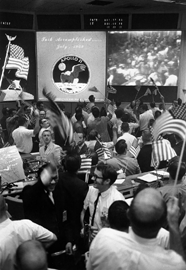
Houston celebrates the successful moon mission, a moment nine years in the making.
YOUNG: Of course there have been moments when American science took us all to new heights.

A launch tower camera captures blastoff.(Courtesy of NASA)
[ROCKET SOUNDS]
YOUNG: They were young men, mostly in their mid-twenties, working with the computing power of a calculator. But somehow they sent three astronauts nearly a quarter-million miles to the moon. And when the Eagle landed, even the crew at Mission Control could hardly believe it.
NASA: We copy you on the ground, you got a bunch of guys about to turn blue, we’re breathing again thanks a lot.
YOUNG: For 40 years now the Apollo mission has been the gold standard for measuring every other challenge facing us - if we can put a man on the moon, why can’t we end poverty or disease?
And most recently the moonshot metaphor’s been applied to global warming. There’s an Apollo Alliance for clean energy. And when former Vice President Al Gore issued his challenge for carbon free electricity he went straight to the words of John Kennedy and Neil Armstrong.
GORE: We must now lift our nation to reach another goal that will change history. Our success depends on our willingness as a people to undertake this journey and to complete it in ten years. Once again we have another opportunity to take a giant leap for humankind.

The Apollo 11 crew relaxes during training. (Courtesy of NASA)
We called on NASA’s Chief Historian, Steve Dick, to learn whether – metaphorically speaking - Apollo is really apt for climate change.
DICK: Well in some ways it is although of course there are many differences. With Apollo we had to - it was really a more defined goal whereas the global climate problem is more amorphous in the sense that we could build the Saturn Five and the Apollo Command Module and the Lunar Lander to go to the moon. But to take care of the global climate change on the earth is much more difficult to do, I think it’s more difficult to get your arms around, although there are of course technologies involved which can help with that.
YOUNG: So, if it is viewed primarily as an engineering kind of problem, then maybe this is the right way to think about it. But obviously with something like climate change, there’s more than just an engineering task at hand.
DICK: That’s right because the technology is one thing, but you may not be able to solve the problems of global climate change with technology alone. I think it’s a lot more amorphous. There would have to be many different technologies. Not one single technology that you focus on.
YOUNG: How have these tools that we’ve developed to understand other planets helped us better understand or own planet?
DICK: Well, certainly if you look at the solar system, the studies that we’ve done on planetary atmospheres, for example, take two of the nearest planets, Mars and Venus. Mars has an atmosphere of about 6 millibars, less than a hundredth of the Earth’s atmosphere, which means that over time Mars lost most of its atmosphere. And why did that happen? On the other hand, on Venus, you have a very dense atmosphere almost entirely carbon dioxide and the temperatures there are above 900 degrees Fahrenheit, and that’s because there’s a runaway greenhouse effect on Venus. So we can use what we learn about other planetary atmospheres to apply to our own Earth atmosphere.
YOUNG: And indeed, that’s inspired a great number of people to start looking more closely at our atmosphere and what’s going on with our atmosphere.
DICK: Uh-huh. That’s right. You can call it comparative planetology. It’s always better to have more than a sample of one.
[LAUGHING]
DICK: … when you’re talking about things on a global basis and the best way to do that is to send the spacecraft out there and study.
YOUNG: And I guess, you know, looking at Venus and Mars, here we are the happy medium in between and we’d like to keep it that way.
DICK: Exactly.
YOUNG: You know, for all of the positive impact and inspiration that came with the moon shot, I wonder if there was also a bit of a downside, though, in that it may have inflated our hubris. And somehow the moon mission gave us a false sense of confidence about could be accomplished through technology alone.
DICK: Well you might say that. And it’s true that technology cannot solve all the problems. And of course it’s not so much the technology as how, you know, what use humans make of that technology. So in the end it always comes down to how the technology is used and that’s a matter of public policy and, you know, in a democratic society it’s something that people should have input in through their elected representatives.
YOUNG: You know, when we look at some of the history of the politics during the buildup to the Apollo mission, it was not uniformly popular. There were a lot of folks in Congress, say, who said “Hey, I could spend that money elsewhere.” Why was it unpopular, and how did the administration overcome that and keep the focus on the mission?
DICK: Well, I think it goes back to the same old problem that we have so many problems on earth, and there’s no doubt that we do have them – had them then, and we still have them now – that that money should be used more wisely on the earth. But I think the way they kept focus back then was this geopolitical context.
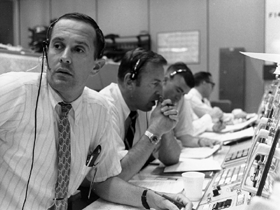
The mood at mission control is tense during the lunar module’s descent. (Courtesy of NASA)
YOUNG: So, again, if people want to apply this analogy “Hey, if we can go to the moon, we can whip climate change.” Maybe the lesson is the public needs to perceive an enemy.
DICK: Well, and the enemy is the carbon emission and all the things that the humans are doing to the Earth’s atmosphere. I guess you could say that we’re in competition with what we’re doing to the atmosphere. Our better aspects for taking care of the Earth are competing with the aspects that are you know, polluting the Earth. So in that way, it is a kind of competition with ourselves, that’s right.
YOUNG: We’ve met the enemy and he’s us as Pogo said.
DICK: [Laughs] Exactly.
YOUNG: Steve Dick is chief historian of NASA. Thank you very much for your time, sir.
DICK: Good talking with you.
[MUSIC: DubXanne “Walking On The Moon” from King Size Dub Chapter 69 – 15 years of Dubspin (Echo Beach 2009)]
Related links:
- NASA celebrates Apollo’s 40th anniversary
- Many environmental groups take inspiration from Apollo’s achievements
- Al Gore on the moon and climate change.
YOUNG: Living on Earth is produced by the World Media Foundation. Our crew includes Bobby Bascomb, Eileen Bolinsky, Bruce Gellerman, Ingrid Lobet, Helen Palmer, Jessica Ilyse Smith, Ike Sriskandarajah, and Mitra Taj, with help from Sarah Calkins, Marilyn Govoni, and Sammy Souza. Our interns are Annie Glausser and Lisa Song. Jeff Turton is our technical director. Alison Lirish Dean composed our themes.
You can find us anytime at loe.org. Steve Curwood is our executive producer.
I’m Jeff Young. Thanks for listening.
Living on Earth wants to hear from you!
Living on Earth
62 Calef Highway, Suite 212
Lee, NH 03861
Telephone: 617-287-4121
E-mail: comments@loe.org
Newsletter [Click here]
Donate to Living on Earth!
Living on Earth is an independent media program and relies entirely on contributions from listeners and institutions supporting public service. Please donate now to preserve an independent environmental voice.
NewsletterLiving on Earth offers a weekly delivery of the show's rundown to your mailbox. Sign up for our newsletter today!
 Sailors For The Sea: Be the change you want to sea.
Sailors For The Sea: Be the change you want to sea.
 The Grantham Foundation for the Protection of the Environment: Committed to protecting and improving the health of the global environment.
The Grantham Foundation for the Protection of the Environment: Committed to protecting and improving the health of the global environment.
 Contribute to Living on Earth and receive, as our gift to you, an archival print of one of Mark Seth Lender's extraordinary wildlife photographs. Follow the link to see Mark's current collection of photographs.
Contribute to Living on Earth and receive, as our gift to you, an archival print of one of Mark Seth Lender's extraordinary wildlife photographs. Follow the link to see Mark's current collection of photographs.
 Buy a signed copy of Mark Seth Lender's book Smeagull the Seagull & support Living on Earth
Buy a signed copy of Mark Seth Lender's book Smeagull the Seagull & support Living on Earth

